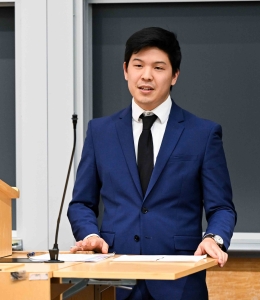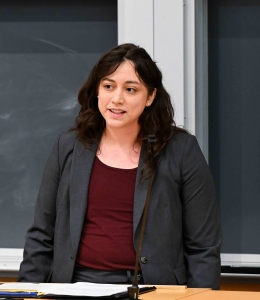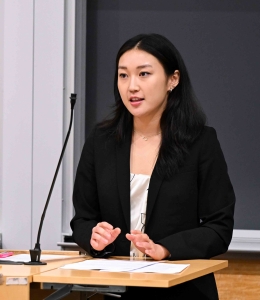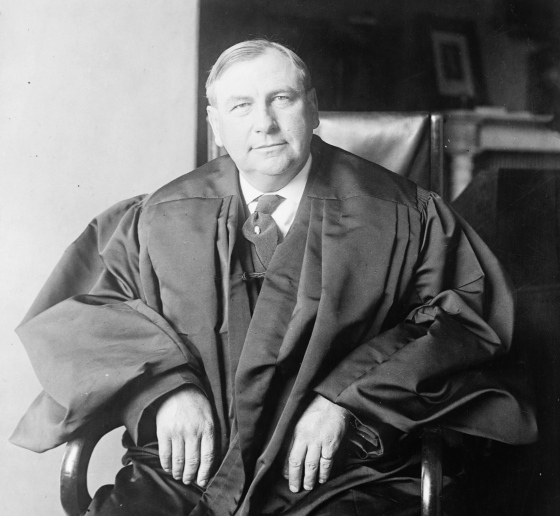Final Four: 2025 Harlan Fiske Stone Moot Court Competition
The year-long competition culminated with finalists Miles Kim ’25, Nicole Morote ’25, Alice Park ’25, and Akesh Shah ’25 arguing before a panel of judges. Morote won the prize for top oralist, and Kim won for best final-round brief.
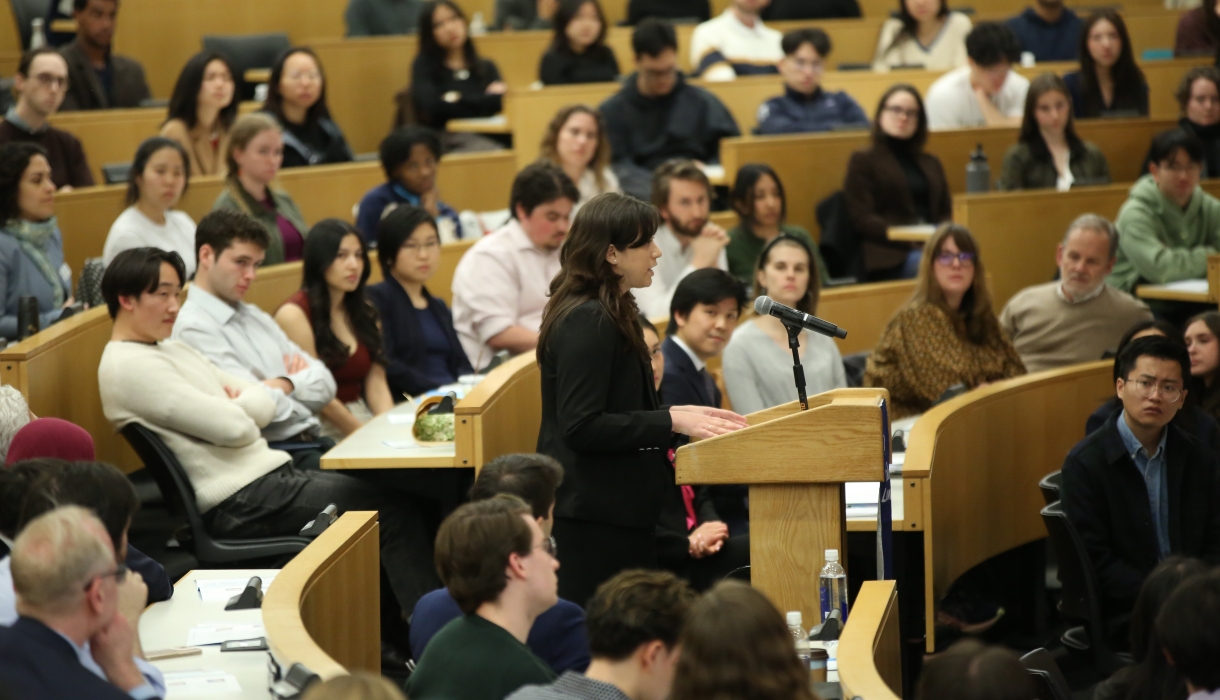
The classroom-turned-courtroom was packed, but no one made a sound as Nicole Morote ’25 walked up to the podium to present her arguments to the three distinguished judges sitting before her. For a moment, she paused, preparing, studying her notes. Then she began, confident and clear: “Good afternoon, your honor, and may it please the court.”
Students who enter the Harlan Fiske Stone Moot Court Competition face an intense, three-round elimination competition to test their appellate advocacy skills. This year, 66 students participated in the qualifying round, briefing issues on behalf of either the appellant or the appellee (students are generally assigned a side throughout the competition) and presented their positions in oral arguments. Sixteen competitors advanced to the spring semifinal round. The two teams with the best overall results advanced to the final round.
In the finals, Nicole Morote ’25 and Akesh Shah ’25, who represented the plaintiffs-appellee, and Alice Park ’25 and Miles Kim ’25, who represented the defendant-appellant, argued a fictional case of a transgender man (J.M.) who brought claims of intentional infliction of emotional distress (IIED) and defamation against his mother (Emily Morgan). The students delivered their arguments before the moot court judges: Judge Cindy K. Chung ’02 of the U.S. Court of Appeals for the 3rd Circuit, Judge Nancy G. Abudu of the U.S. Court of Appeals for the 11th Circuit, and Judge Kenneth M. Karas ’91 of the U.S. District Court for the Southern District of New York.
Written by the competition’s student co-directors, Shreya Agarwala ’25 and Robert Kreklau ’25, the case dealt with complicated jurisdictional questions: J.M. and his father (who sued on J.M.’s behalf when J.M. was a minor) claimed Morgan, a social media influencer with more than a million followers, caused J.M. emotional distress through her social media posts over many years and by sending J.M. to an all-girls boarding school with extreme disciplinary measures. J.M. additionally claimed that Morgan defamed him in a public online response to his college personal statement (which had been leaked) by calling him a drug addict and alleging he lied about being transgender on his college applications.
The questions on appeal centered on whether the district court erred in selecting D.C. law, rather than New York law, for Morgan’s motion for summary judgment on the intentional infliction of emotional distress (IIED) claim (J.M. and his father live in D.C.; Morgan lives in New York) and whether the court erred in denying Morgan’s motion for summary judgment on the defamation claim, to which the parties agreed New York law applies. (Read more about the case and questions presented.)
The Competition
Starting things off, Park argued that New York law should apply to the IIED claim because most of the relevant conduct occurred when J.M. lived in that state. She also said the mother’s actions would not meet the high bar of “extreme and outrageous” conduct required under that state’s law and that New York never intended for IIED claims to cover the parent-child relationship.
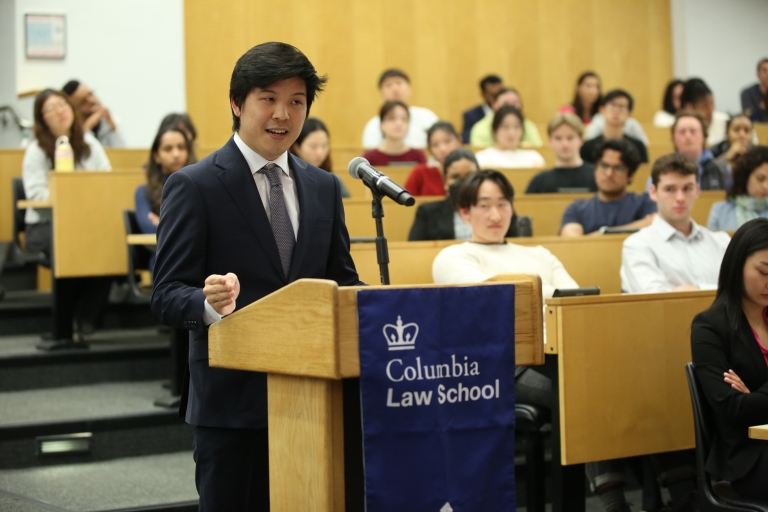
Abudu asked how the panel should treat the fact that the plaintiff’s father “had a completely different response” to J.M.’s gender dysphoria. “Now you have two parents of the same child handling the situation very differently,” the judge said.
“And that’s exactly, your honor, why New York courts don’t consider these kinds of intimate, private parent-child disputes in the context of even tort claims generally but especially in IIED,” Park said, adding that “those disputes are better resolved in family court or divorce proceedings.”
Representing the plaintiff on the choice of law issues, Shah argued that the mother’s conduct—including a “decades-long campaign of gender conversion therapy”—was outrageous under either state’s laws. But he also said the most egregious harm to J.M. came while he was living in D.C.
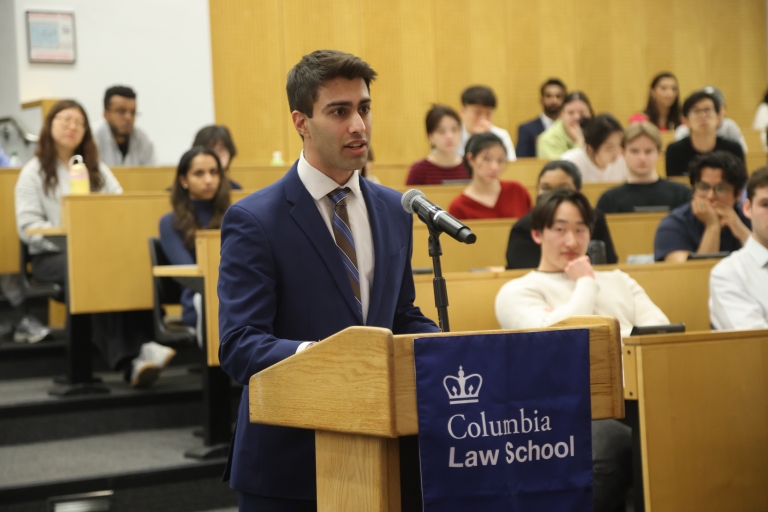
On the defamation claim, Kim argued on behalf of the mother that she makes her living “selling a sensationalized version of her life as a parent on social media.” As such, he said, no “reasonable juror” would believe she was sharing facts rather than opinions.
But the judges pointed out that the mother had prefaced her posts by saying she was going to tell her followers the truth. “Ms. Morgan lays down the marker when she says it’s time to clear up what’s happening, and she wants to tell the truth,” Karas said. “She even talks about how her brand is all about being honest. That speaks the language of ‘I’m about to share facts about my child.’”
Kim responded that “a reasonable listener would understand those types of statements to be commonplace promotional efforts from savvy content creators like Ms. Morgan.”
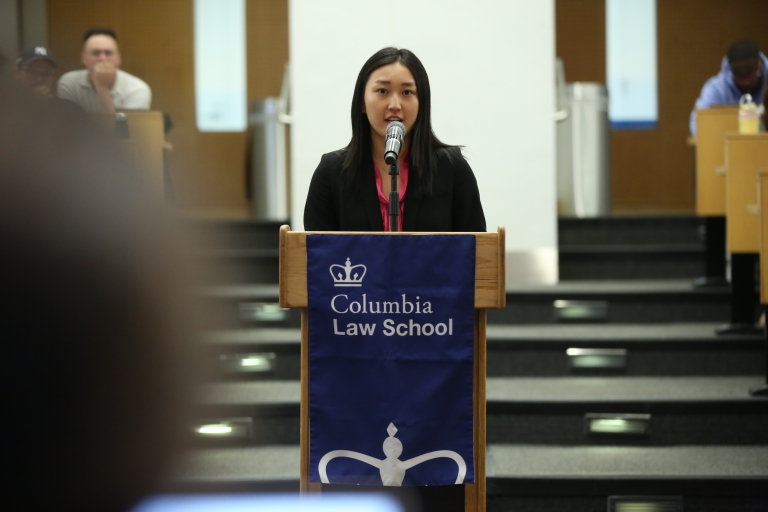
Kim also argued that New York’s anti-SLAPP (Strategic Lawsuits Against Public Participation) law bars J.M.’s defamation claim because the mother’s posts involved matters of public interest.
Arguing the other side, Morote said that “when a reasonable listener is repeatedly told that what’s about to follow is the truth, then a reasonable listener is likely to take it as exactly that.”
On the anti-SLAPP issue, Chung asked Morote, “How do you answer the argument that this is a broader discourse about child-rearing?”
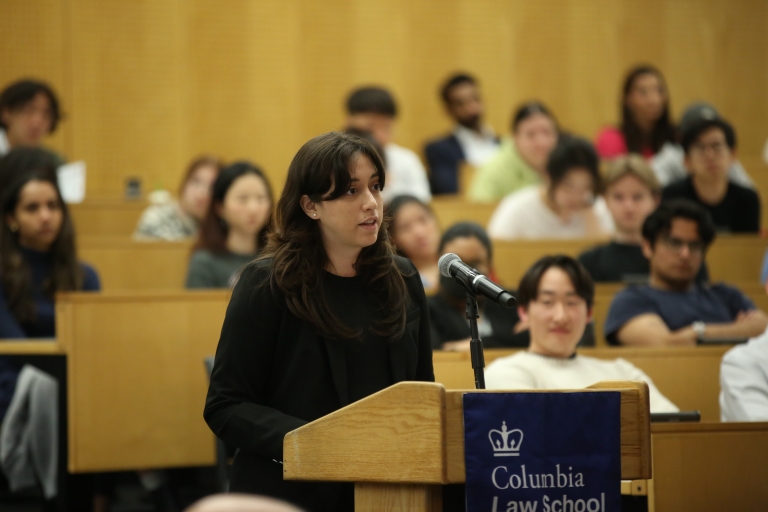
Morote said both J.M.’s posts and his mother’s posts were about their own lives and experiences, not about “broader social or cultural topics.”
“For this court to say that the ambit of [New York’s relevant law] is so wide that it reaches this dispute today would be to go farther than New York courts have gone,” she said.
And the Winners Are …
After more than an hour of arguments, the judges delivered the results: Morote was awarded the Lawrence S. Greenbaum Prize for best oral presentation, and Kim won for best final-round brief. (Judges question competitors throughout their arguments but do not issue a decision on the fictional case.)
The judges praised the finalists. “I’ve been doing my job for about 20 years, and you all are already at the top 1%” of oral advocates, Karas said. “Just incredible composure.”
Chung also expressed admiration for the students who wrote the case, which she called “amazing” and “so well done.”
Reflecting on how they wrote the case, Kreklau said they wanted to focus on transgender youth and so-called social media influencers who profit from sharing their children’s lives on the internet. The practice, sometimes called “sharenting,” was also the focus of Agarwala’s student note, “Children’s Privacy and the Ghost of Social Media Past,” published this year in the Columbia Human Rights Law Review. “While my note proposes a new legal solution to the issue, I wondered how children could tackle the problem within current law,” she said.
Above all, for the co-directors, watching the case unfold throughout the competition was “incredible,” they said. “The feeling is hard to describe, but there is certainly a level of awe for the students and judges with such a strong grasp of the record, and pride watching our work come to life.”
The three-round Harlan Fiske Stone Moot Court Competition—part of the Paul, Weiss, Rifkind, Wharton & Garrison Moot Court Program—is run by Director of Legal Writing and Moot Court Programs Sophia F. Bernhardt, Associate Director of Legal Writing and Moot Court Programs Amanda Sen Villalobos, Paul J. Kellner Professor of Law Daniel Richman, and the moot court board: Agarwala and Kreklau, along with Executive Director Jaylene K. Yi ’25; Foundation Moot Court Director Yashi Wang ’25; Managing Directors Skylar Jaeger ’25, Austin Aguiñaga ’25, Jiachen Feng ’25, and Madeline Everett ’25; Specialized Moot Court Director Angela Hyokyoung Kang ’25; and Director of Community Programs Cole D. Riley '25.
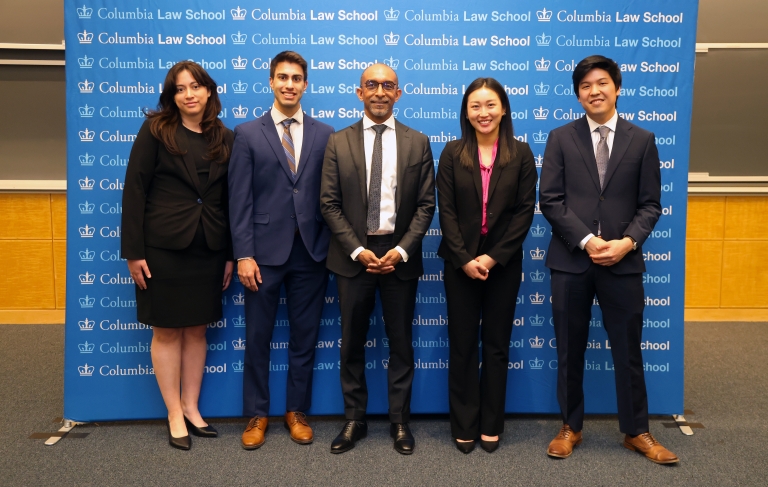
After the finals, Morote said it was “such a privilege” to argue in front of the judges. “I’m overwhelmed and beyond honored,” she said. “I owe a world of gratitude to the friends, family, and mentors who have so selflessly given their time to teach and support me.”
Kim, recipient of best brief, added that he enjoyed the experience. “I had so much fun arguing in front of the judges,” he said. “They asked me a lot of questions I had never been asked before, which was both nerve-racking and exciting.”
